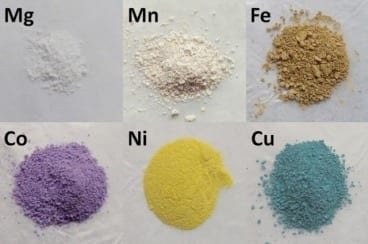
Project provides a systematic way of exploring the vast realm of unfamiliar materials.
Trying to find new materials, to improve the performance of anything from microchips to car bodies, has always been a process of trial and error. MIT materials scientist Gerbrand Ceder likens it to setting out from Boston for California, with neither a map nor a navigation system — and on foot.
But, he says, after centuries of doing materials research the old-fashioned way, a significant revolution is underway, thanks to a massive computerized database and simulation system that can sort through thousands of potential materials in the time it previously might have taken to study just one. The system is called the Materials Project; while only about three years old, it has already produced significant new findings.
For example, researchers using the Materials Project’s online tools found entirely new types of transparent conducting materials — a class crucial for devices with touch screens, such as smartphones — that do not exist in nature and whose existence had not been predicted. Others have used the system to find new materials that could find uses in battery electrodes and semiconductors.
There are a total of about 35,000 known inorganic compounds, Ceder says; nearly all are included in the Materials Project’s database, The data also includes thousands of unknown compounds that do not exist in nature and have not yet been synthesized in the laboratory — but whose basic characteristics can be predicted using complex computations based on quantum mechanical theory. The vision is to create a compendium of materials’ characteristics: electrical conductivity, crystal structure, hardness, stability, and so on.
Ceder and colleagues at MIT and the Lawrence Berkeley National Laboratory (LBNL) have described this new approach, which they call “high-throughput computational materials design,” in recent articles in Scientific American and APL Materials. Their work has inspired the White House to launch a national effort, now called the Materials Genome Initiative (the initial name of the project led by MIT and LBNL), to spread the new approach to institutions around the country.
“We know very little about the world of chemical compounds around us,” says Ceder, the Richard P. Simmons Professor of Materials Science and Engineering. “If you pick a random compound out of the ones we know, and ask, ‘How hard is it? Is it a good conductor? What color does it have? Is it stiff?’ — you wouldn’t know the answer.” A rough estimate, he says, is that we know less than 1 percent of the properties of the compounds around us.
And that’s just counting the basic properties, Ceder says: The knowledge is even sparser when it comes to “engineering behavior” — the more detailed knowledge, such as durability under stress or susceptibility to corrosion, needed to choose a material for a specific application. The plan to build a comprehensive database of materials’ properties, he says, lays a foundation, much as the Human Genome Project has established baseline knowledge about the genetic basis of human characteristics.
“A lot of these properties can now be computed,” Ceder says. The aim of the Materials Project, over the next few years, is to “just compute these properties for all known compounds, and some unknown ones.” With that information, engineers could use a computer to screen thousands of materials for a particular application, based on the specific properties that are needed.
For example, Procter & Gamble asked Ceder and his colleagues to screen all possible materials for a new electrode for the company’s Duracell batteries. The team was able to screen 130,000 real or hypothetical compounds, devising a list of 200 that met the desired criteria and that had the potential to perform better than the materials now used. Another company used the system to discover a new catalyst for splitting water into hydrogen and oxygen; a third used it to find a new material to be used in computer memory chips.
The hope is that within five to 10 years, the database will contain information on the basic properties of all compounds that can exist. That will take “a few million CPU hours over the next few years,” Ceder says — which sounds like a lot, but is actually a relatively small amount compared to some computationally intensive tasks such as climate modeling or simulating explosions, he says.
This, he says, would allow modern materials scientists to progress from something akin to 16th-century explorers — trying to learn about a continent without maps or compasses — to today’s travelers, with their GPS devices.
“We don’t get lost anymore,” Ceder says. But as with maps, the Materials Project doesn’t tell you where to go, it just tells you how to get there: “It’s still up to you to decide what properties you need.”
The Latest on: Materials Project
[google_news title=”” keyword=”Materials Project” num_posts=”10″ blurb_length=”0″ show_thumb=”left”]
via Google News
The Latest on: Materials Project
- West Elm Dupe: Make This Faux Leather Tray With Dollar Store Materialson May 8, 2024 at 9:38 am
I’m excited to share a West Elm dupe that you can easily make yourself with dollar store materials! If you’re anything l ...
- State may reopen Hart-Miller Island for dredged materials from planned Tradepoint terminalon May 8, 2024 at 6:00 am
Conversations are underway for Hart-Miller Island on the Chesapeake Bay to accept dredge material for the first time in 15 years.
- Thompson announces new Project Echo seating aestheticon May 8, 2024 at 2:12 am
While Thompson Aero Seating’s expertise in the design, innovation and production of luxury seating is well established, the company is now putting the spotlight on an often-overlooked aspect of ...
- AMG Critical Materials Sees Positive Effect From On-Schedule Lithium Projects -- Commodity Commenton May 7, 2024 at 12:59 pm
AMG Critical Materials says its lithium projects are on schedule and expects a "substantially positive impact" from them. On 2024 outlook and lithium projects: "Regarding 2024 outlook, low prices ...
- Wonder Material 'More Remarkable' Than Graphene Has Medical Potentialon May 7, 2024 at 8:55 am
Borophene is already thinner and more conductive than graphene, and scientists have altered it to make it even more special.
- World’s Biggest Construction Project Gets a Reality Checkon May 6, 2024 at 9:01 pm
Saudi Arabia’s plans for twin 100-mile-long skyscrapers have lost momentum amid spiraling costs and construction glitches.
- Fish residues can compensate for raw materials shortages and improve our health in the bargainon May 6, 2024 at 11:04 am
More than a million tons of fish residues can rescue the food and cosmetic industries from raw materials shortages—and create new jobs. The key factors here are oils rich in omega-3, collagen and ...
- Silk Laundry Merges Conservation With Material Innovationon May 6, 2024 at 6:00 am
Australia-based fashion brand Silk Laundry bought those acres in 2020 from a family—who owned it for a century— for 400,000 Australian dollars (roughly $265,000) and planted more than10,000 trees ...
- Thermal Energy Announces $1.9 million Turn-key Heat Recovery Project for a Global Materials Companyon May 6, 2024 at 4:01 am
Project designed to help customer achieve ambitious carbon ... has announced a $1.9 million carbon reduction and energy efficiency solution for a global materials company. All figures are shown in CAD ...
- Community news includes TxDOT project meeting, resource festival, moreon May 5, 2024 at 2:08 am
Upcoming Amarillo area events and college news of note, including a new degree plan using hybrid learning strategies.
via Bing News









